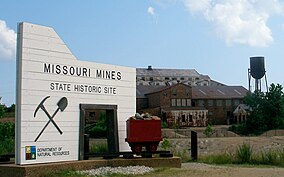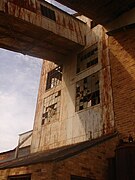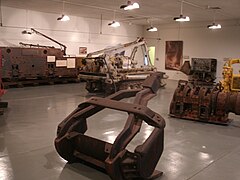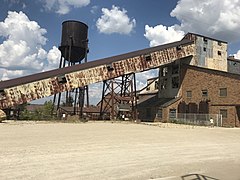
The Ozarks, also known as the Ozark Mountains, Ozark Highlands or Ozark Plateau, is a physiographic region in the U.S. states of Missouri, Arkansas, Oklahoma and the extreme southeastern corner of Kansas. The Ozarks cover a significant portion of northern Arkansas and most of the southern half of Missouri, extending from Interstate 40 in central Arkansas to Interstate 70 in central Missouri.

The California State Mining and Mineral Museum is a museum of the state park system of California, United States. The museum exhibits and interprets the state's mineral resources and mining heritage. It is located in Mariposa, a city in central California, on the Mariposa County fairgrounds.

Meramec State Park is a public recreation area located near Sullivan, Missouri, about 60 miles from St. Louis, along the Meramec River. The park has diverse ecosystems such as hardwood forests and glades. There are over 40 caves located throughout the park, the bedrock is dolomite. The most famous is Fisher Cave, located near the campgrounds. The park borders the Meramec Conservation Area.

The Southeast Missouri Lead District, commonly called the Lead Belt, is a lead mining district in the southeastern part of Missouri. Counties in the Lead Belt include Saint Francois, Crawford, Dent, Iron, Madison, Reynolds, and Washington. This mining district is the most important and critical lead producer in the United States.

New Almaden, known in Spanish as Nueva Almadén, is a historic community and former mercury mine in the Capitancillos Hills of San Jose, California, located at the southwestern point of Almaden Valley in South San Jose. New Almaden is divided into two parts: the mines and much of their immediate surroundings, including historic ghost town settlements in the Capintancillas, which together form the Almaden Quicksilver County Park, and the largely residential historic district surrounding the Casa Grande.
The following is a list of Registered Historic Places in Iron County, Michigan. The list includes 79 structures and historic districts that are significant for their architectural, historical, or industrial/economic importance.

Hill-Annex Mine State Park is a state park of Minnesota, United States, interpreting the open-pit mining heritage of the Mesabi Range. The park is located north of the city of Calumet, in Itasca County, Minnesota. The park provides access to fossil material exposed by mining from the Cretaceous era Coleraine Formation.

Chat is fragments of siliceous rock, limestone, and dolomite waste rejected in the lead-zinc milling operations that accompanied lead-zinc mining in the first half of the 20th century. Historic lead and zinc mining in the Midwestern United States was centered in two major areas: the tri-state area covering more than 2,500 square miles (6,500 km2) in southwestern Missouri, southeastern Kansas, and northeastern Oklahoma and the Old Lead Belt covering about 110 square miles (280 km2) in southeastern Missouri. The first recorded mining occurred in the Old Lead Belt in about 1742. The production increased significantly in both the tri-state area and the Old Lead Belt during the mid-19th century and lasted up to 1970.

Pendarvis is a historic site located in Mineral Point, Iowa County, Wisconsin, United States. The site, which is listed on the National Register of Historic Places, is made up of several 19th century cabins built by Cornish immigrants who came to Mineral Point to mine lead. Today the site is owned by the Wisconsin Historical Society and serves as a museum of Wisconsin's early lead mining history. Programs at the site also interpret the groundbreaking preservation work by Robert Neal and Edgar Hellum, begun during the Great Depression.
Battle of Athens State Historic Site is an historic battlefield and state park located in Clark County, Missouri, along the banks of the Des Moines River. It is the site of the Battle of Athens, fought in 1861 during the American Civil War. The site serves as an open-air museum interpreting the battle and its aftermath. It is one of the northernmost places in the state.
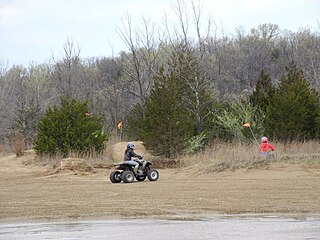
St. Joe State Park is a public recreation area consisting of 8,243 acres (3,336 ha) on the south side of Park Hills, Missouri, along the flanks of the Saint Francois Mountains. The state park includes the Missouri Mines State Historic Site with its former St. Joe Minerals mill buildings and museum of geology and mining. The park features a 2,000-acre (810 ha) off-road vehicle (ORV) riding area located on the old lead mine tailings dumps, camping facilities, and trails for hiking, bicycling, and horseback riding.
The Doe Run Resources Corporation, known by the trade name The Doe Run Company, is a privately held natural resources company and global producer of lead, copper, and zinc concentrates. It owns four mills, six mines and a lead battery recycling plant, all in southeast Missouri, United States, and a subsidiary Fabricated Products Inc. with locations in Arizona and Washington. It also owns two former primary lead smelter sites in the U.S. that are currently being remediated. It is wholly owned by The Renco Group, Inc

Watkins Mill in Lawson, Missouri, United States, is a preserved woolen mill dating to the mid-19th century. The mill is protected as Watkins Woolen Mill State Historic Site, which preserve its machinery and business records in addition to the building itself. It was designated a National Historic Landmark and added to the National Register of Historic Places in 1966 in recognition for its remarkable state of preservation. The historic site is the centerpiece of Watkins Mill State Park, which is managed by the Missouri Department of Natural Resources.

The Mines of Spain State Recreation Area and E. B. Lyons Nature Center is a state park in Dubuque County, Iowa, United States. It is near Dubuque, the eleventh-largest city in the state. The park features picnic areas, 15 miles (24 km) of walking/hiking trails, 4 miles (6.4 km) of ski trails, and the Betty Hauptli Bird and Butterfly Garden. It also includes archaeological sites of national importance as an early lead mining and smelting venture led by French explorer Julien Dubuque, as well as Dubuque's gravesite. These sites were collectively designated a National Historic Landmark District as Julien Dubuque's Mines.
Van Meter State Park is a public recreation area on the Missouri River in Saline County, Missouri. The state park consists of 1,105 acres (447 ha) of hills, ravines, fresh water marsh, fens, and bottomland and upland forests in an area known as "the Pinnacles." The park has several archaeological sites, a cultural center, and facilities for camping, hiking, and fishing. It is managed by the Missouri Department of Natural Resources.
Finger Lakes State Park is a public recreation area consisting of 1,128 acres (456 ha) in Boone County near the city of Columbia, Missouri. The state park is unusual in that the site was reclaimed after having been strip mined for coal. It is one of two state parks in Missouri used for off-road vehicles. The history of the other, St. Joe State Park, is also connected with mining. It is adjacent to Rocky Fork Lakes Conservation Area.

Gen. John J. Pershing Boyhood Home State Historic Site in Laclede, Missouri, is maintained by the Missouri Department of Natural Resources as a state historic site. General John Joseph "Jack" Pershing lead the American Expeditionary Forces in World War I and attained the rank of General of the Armies. Pershing was born on a farm outside Laclede, but lived in the home from age six to adulthood. The historic site preserves and interprets the boyhood home and the one-room Prairie Mound School at which he taught for a year before attending West Point Military Academy. The home has been listed on the National Register of Historic Places since 1969, and was designated a National Historic Landmark in 1976.
Desloge Consolidated Lead Company was a lead mining company in the Southeast Missouri Lead District that was operated by the Desloge family in the 19th and early 20th century. The Desloge lead operations in the "Old Lead Belt", in the eastern Ozark Mountains, helped Missouri become the world's premier lead mining area.
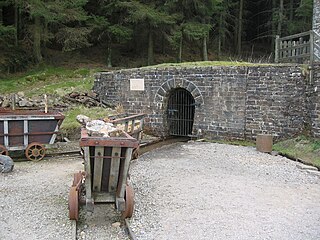
The North of England Lead Mining Museum, better known as Killhope, is an industrial museum near the village of Cowshill, County Durham, England. The museum stands on the site of the former Park Level Mine, which is being restored to show the workings of a 19th-century lead mine.

The Holden/Marolt Mining and Ranching Museum is located on the former Holden Mining and Smelting Company facility on the western edge of the city of Aspen, Colorado, United States. It consists of one remaining building and the remains of some others. In 1990 it was recognized as a historic district and listed on the National Register of Historic Places, the only district in the city to be so recognized.
